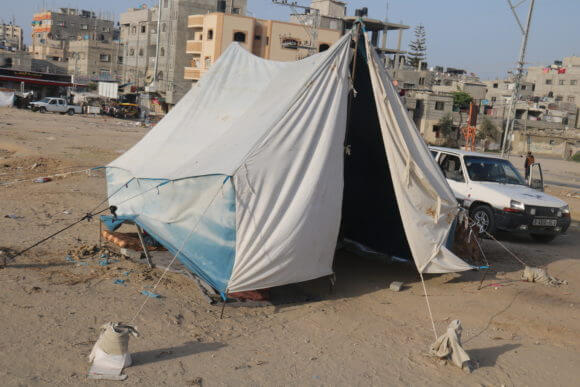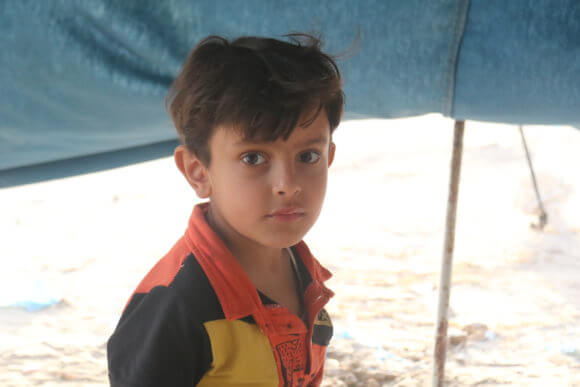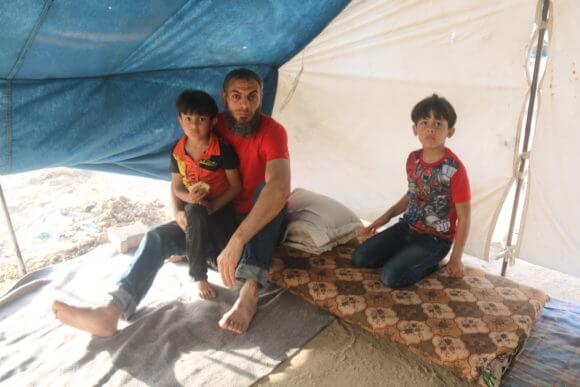Amid growing financial strain, Palestinians in Gaza who are unable to pay rent are now living in tents. Most were tradesmen who lost their jobs in recent years. Some were once part of Gaza’s slim middle-class. Of those with degrees, many studied hard sciences. After a decade of siege on Gaza’s crumbling economy, even once reliable work is scarce.
Majed Alian, 37, from Nuseirat refugee camp in central Gaza is married to Raja, 34, and they have two children, Muntasser, 8, and Oday, 6. Raja has a degree in pharmacy from Al-Azhar University. She graduated ten years ago and was never able to find a job. Unable to buy a home, they rented a three-bedroom apartment.
Alian and his family have lived in that same rental unit since he got married nine years ago. Before their eviction, the family went into debt. For four months he was not able to pay rent for the apartment where they lived, which cost around $130 a month.
The landlord gave him until the end of May to either pay the rent or vacate the apartment, which pushed him to borrow a tent from a friend. He placed it in a lot adjacent to an outdoor market in the cramped refugee camp, thus finding a temporary home for his family.
“I prefer to live in a tent in the street over being imprisoned because of the accumulation of debt,” he told Mondoweiss. “My family and I are homeless now and I hope our story will win the attention of every human with a conscience.”
Alian was a contractor for the last seven years. After he graduated high school he took up the trade of making granite kitchen counters. With extensive experience, his latest job was with the Zumurt Company for Granite, the largest granite company in the Gaza Strip. Yet, this changed recently as many companies are terminating the contracts of their staff due to the lack of demand in the Gaza Strip due to the lack of liquidity in the market.
Even if Zumurt hired him back, after years of manual labor Alian now has a back injury making finding another construction job impossible. His trade requires the physical ability to carry and cut stones. What’s more, in the last year Alian sprained his ankle.
Nearby, Majed Abu Awad, 47, married with six children, is on the brink of homelessness after losing a construction job. He now has no source of income and several months of unpaid rent on a two-room house also in Nuseirat refugee camp.
“Before the start of the Israeli siege on Gaza in 2006, the situation in Gaza was good, and the movement of goods and people was fine. We had work. Yet, since the imposition of the siege on Gaza, Gaza’s workers have become unemployed,” Abu Awad said.
According to the World Bank, Gaza’s unemployment rate has jumped over ten percent in the past five years, reaching 52 percent last April. For youth, employment is 67 percent. In the last year alone the Palestinian Ministry of Economy reported Gaza’s GDP fell by 8 percent and the industrial sector dropped 8.8 percent.
Looking back, the decline began when Israeli first imposed a siege over Gaza in 2006. The tightening of imports and exports and restrictions on movement significantly downturned the economy. Today, around 80 percent of Gaza’s economy is supported by donor aid transferred from the West Bank-based Palestinian Authority. But cuts over the last year have squeezed families in unprecedented ways.
Public employees in Gaza only receive half of their salaries, and employees in Gaza of the West Bank government no longer receive a salary.


Public employees face homelessness
Ibrahim Ayad, 39, works for the Hamas-run Gaza government, and is at the risk of being evicted from his apartment along with his family of four.
Ayad owes $2,000 in unpaid rent from the last year. He is paid only 40 percent of his salary every 50 days because of payroll freezes.
Ayad expressed sadness at his inability to meet the wishes of his children, explaining that what he does earn lasts about a day after paying down his debt to his landlord and a shop where he buys items to support the basic needs of his family. There are also electricity and water bills.
Ziad Abu Hashish, an academic and researcher in social and economic affairs in the Gaza Strip at Al-Aqsa University, described the coastal enclave as a crisis area.
“The percentage of people living below the poverty line in the Gaza Strip exceeded all expectations, and the siege did not spare any segment of the society, and those living in rental houses face either imprisonment or eviction along with their families,” Abu Hashish said.
He pointed to a noticeable new phenomenon in Gaza where the families who end up homeless had at one time lived in one room in the houses of relatives.
Moreover, cash aid from humanitarian groups has stopped in recent months.
In March the Israeli human rights group B’Tselem found that the homes of 13,000 Palestinians destroyed still have not been rebuilt. Of them around 1,600 families receive rent subsidies. Yet Trump administration freezes this year to the balloon fund covering the disbursements through UNRWA, the United Nations agency supporting Palestinian refugees, are “leaving families out in the cold. Families that are still renting are having trouble making payments,” the report said.
Abdallah Aljamal, a Gaza-based journalist, contributed reporting to this article.



Is this Kushner’s aim…to help these people? The likes of Kushner only know how to help themselves.
Needless to say, the horrors Zionists have inflicted and continue to inflict on the defenseless long suffering indigenous Palestinians caged by “Israel” in the Gaza Strip are a hideous insult against and a betrayal of the six million Jews who perished at the hands of the Nazis. It’s utterly beyond me how they can live with it!